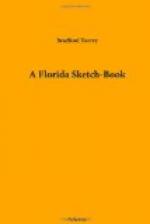Now, alas, Florida seems very far off. I am never likely to walk again under those New Smyrna live-oaks, nor to see again all that beauty of the Hillsborough. And yet, in a truer and better sense of the word, I do see it, and shall. What a heavenly light falls at this moment on the river and the island woods! Perhaps we must come back to Wordsworth, after all,—
“The light that never was, on sea or land.”
A MORNING AT THE OLD SUGAR MILL.[1]
[Footnote 1: I have called the ruin here spoken of a “sugar mill” for no better reason than because that is the name commonly applied to it by the residents of the town. When this sketch was written, I had never heard of a theory since broached in some of our Northern newspapers,—I know not by whom,—that the edifice in question was built as a chapel, perhaps by Columbus himself! I should be glad to believe it, and can only add my hope that he will be shown to have built also the so-called sugar mill a few miles north of New Smyrna, in the Dunlawton hammock behind Port Orange. In that, to be sure, there is still much old machinery, but perhaps its presence would prove no insuperable objection to a theory so pleasing. In matters of this kind, much depends upon subjective considerations; in one sense, at least, “all things are possible to him that believeth.” For my own part, I profess no opinion. I am neither an archaeologist nor an ecclesiastic, and speak simply as a chance observer.]
On the third or fourth day of my sojourn at the Live Oak Inn, the lady of the house, noticing my peripatetic habits, I suppose, asked whether I had been to the old sugar mill. The ruin is mentioned in the guide-books as one of the historic features of the ancient settlement of New Smyrna, but I had forgotten the fact, and was thankful to receive a description of the place, as well as of the road thither,—a rather blind road, my informant said, with no houses at which to inquire the way.




